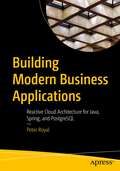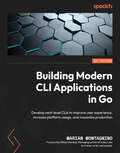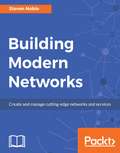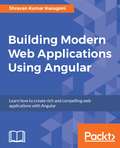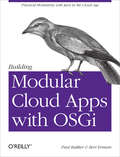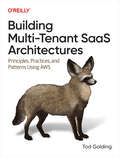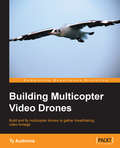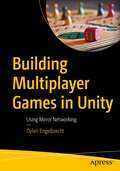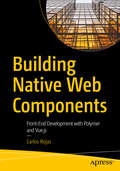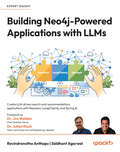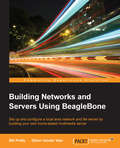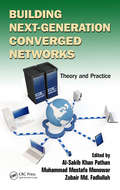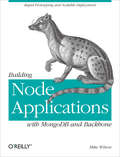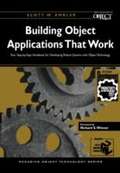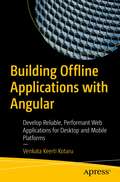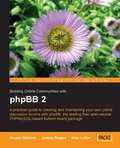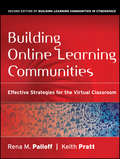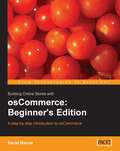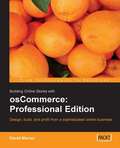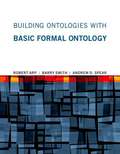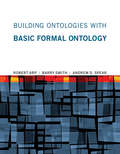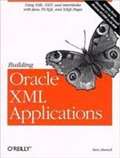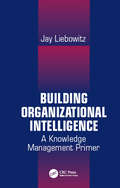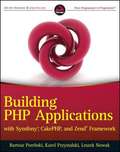- Table View
- List View
Building Modern Business Applications: Reactive Cloud Architecture for Java, Spring, and PostgreSQL
by Peter RoyalDiscover a new way of thinking about business applications in light of the massive industry shift toward cloud computing and reactive programming technologies. This book synthesizes technologies and techniques such as event sourcing, command query responsibility segregation (CQRS), property-based testing, and GraphQL into a cohesive guide for modern business applications that benefit every developer.The book begins with a look at the fundamentals of modern business applications. These fundamentals include business rules and the managing of data over time. The benefits of reactive techniques are explained, including how they are fundamentally aligned with what application developers strive to achieve in their work.Author Peter Royal equips you with sound guidance to follow as you evolve your existing systems, as well as examples of how to build those systems using modern techniques in Spring, Java, and PostgreSQL.What You Will LearnArchitect business applications for cloud-based environmentsDesign sustainable business applicationsIntegrate GraphQL best practices into business applicationsUse property-based testing to exhaustively test possible system statesThink about business applications in terms of message flowsRelate the benefits of reactive systems to business goalsModel time appropriately for business requirementsWho This Book Is ForPracticing software developers who are building business applications, developers who are being asked to deploy into cloud environments that are more volatile than statically provisioned data centers, developers who want to increase the reliability of their systems and are struggling to find the right paradigms and architectures to achieve their goals, developers who see and use capabilities in software in other areas of their lives and want to bring those capabilities into their own work, and developers with experience designing other types of software who want to learn how to design business applications
Building Modern CLI Applications in Go: Develop next-level CLIs to improve user experience, increase platform usage, and maximize production
by Marian MontagninoEvolve the humble CLI using Go and unleash the next generation of powerful, flexible, and empathy-driven interfacesPurchase of the print or Kindle book includes a free PDF eBookKey FeaturesDiscover how Go enables the development of elegant and intuitive CLIsExplore a range of CLI development aspects and pick up a vast array of best practicesCreate engaging and user-friendly interfaces and learn how to distribute themBook DescriptionAlthough graphical user interfaces (GUIs) are intuitive and user-friendly, nothing beats a command-line interface (CLI) when it comes to productivity. Many organizations settle for a GUI without searching for alternatives that offer better accessibility and functionality. If this describes your organization, then pick up this book and get them to rethink that decision.Building Modern CLI Applications in Go will help you achieve an interface that rivals a GUI in elegance yet surpasses it in high-performance execution. Through its practical, step-by-step approach, you'll learn everything you need to harness the power and simplicity of the Go language to build CLI applications that revolutionize the way you work.After a primer on CLI standards and Go, you'll be launched into tool design and proper framework use for true development proficiency. The book then moves on to all things CLI, helping you master everything from arguments and flags to errors and API calls. Later, you'll dive into the nuances of empathic development so that you can ensure the best UX possible, before you finish up with build tags, cross-compilation, and container-based distribution.By the end of this UX book, you'll be fully equipped to take the performance and flexibility of your organization's applications to the next level.What you will learnMaster the Go code structure, testing, and other essentialsAdd a colorful dashboard to your CLI using engaging ASCII bannersUse Cobra, Viper, and other frameworks to give your CLI an edgeHandle inputs, API commands, errors, and timeouts like a proTarget builds for specific platforms the right way using build tagsBuild with empathy, using easy bug submission and tracebackContainerize, distribute, and publish your CLIs quickly and easilyWho this book is forThis book is for beginner- and intermediate-level Golang developers who take an interest in developing CLIs and enjoy learning by doing. You'll need an understanding of basic Golang programming concepts, but will require no prior knowledge of CLI design and development. This book helps you join a community of CLI developers and distribute within the popular Homebrew package management tool.
Building Modern Networks
by Steven NobleGain the edge with SDN, NFV, network virtualization, and networking on clouds About This Book • Navigate through the complexities of delivering modern networking services with practical techniques and solutions • Build robust software defined networks and solve real-world problems involving challenges with next generation networks • Discover the best practices used by top industry professionals for network-related architecture, services, and applications and secure your networks Who This Book Is For This book is for Network Engineers and Network Administrators who are taking their first steps when deploying software-defined networks. Network Architects will also find this book useful when designing and building modern networks. What You Will Learn • Understand Traditional Network Challenges to match modern applications requirements • Find out all about Next Generation Networks (NGN) • Explore the different APIs used to control NGN devices • Understand the different software controllers available to manage NGN hardware • Design a next generation network In Detail As IT infrastructures become more software-defined, networking operations tend to be more automated with falling levels of manual configuration at the hardware level. Building Modern Networks will brush up your knowledge on the modern networking concepts and help you apply them to your software-defined infrastructure. In this book you'll gain the knowledge necessary to evaluate, choose, and deploy a next generation network design. We will cover open and closed network operating systems (NOS) along with the protocols used to control them such as OpenFlow, Thrift, Opflex, and REST. You will also learn about traffic engineering and security concepts for NGNs. You will also find out how to fine-tune your network using QoS and QoE. By the end of the book, you'll be well versed in simplifying the way you design, build, operate, and troubleshoot your network. Style and Approach This practical tutorial shows you real-world solutions to design and build network services through cutting edge research.
Building Modern Web Applications Using Angular
by Shravan Kumar KasagoniDesign and develop next generation web applications using Angular 2 and Angular 4 About This Book • Learn about the core building blocks of Angular • Build and architect high performance web applications • Implement the latest JavaScript concepts in ECMAScript 2015, ECMAScript 2016, and TypeScript • Leverage the latest Angular features to get the most out of your web applications Who This Book Is For This book is targeted at JavaScript developers who are interested in learning how to build rich and powerful web applications with the latest version of Angular. Working knowledge of Angular 1 will be beneficial. What You Will Learn • Develop a frontend web application using component-based architecture • Use ES5, ES2015, and TypeScript to build Angular 4 UI applications • Develop simple to complex user interfaces in Angular 4 • Develop and handle forms in Angular 4 UI applications • Test UIs built in Angular 4 • Use material design components and animations in Angular 4 In Detail In the last few years, Angular has established itself as the number one choice of JavaScript Developers. What makes Angular special is performance and productivity. With Angular, developers can work on consistent coding patterns and build web applications that are powerful and scalable. This book will you get you up and running with Angular and teach how to build modern web applications. It starts with basics of Angular 2 and then brushes you up with the new features of Angular 4. You will learn the core concepts involved in building web applications with Angular such as Data Binding, Routing, Dependency Injection, and much more. The book teaches how to build components and use them to build web apps of your choice. It will help you to handle different kinds of forms and learn the concept of reactive programming. Finally the book teaches how to build visually appealing and responsive UIs. Style and approach It follows a practical approach to explain almost every feature of Angular 2 and Angular 4 and their concepts through real-world examples. In each chapter, a different example is used so that you can build a foundation and understand the concepts by applying them in different scenarios.
Building Modular Cloud Apps with OSGi: Practical Modularity with Java in the Cloud Age
by Paul Bakker Bert ErtmanIf you’re an experienced Java developer in the enterprise, this practical, hands-on book shows you how to use OSGi to design, develop, and deploy modular cloud applications. You’ll quickly learn how to use OSGi, through concise code examples and a set of best practices derived from the authors’ experiences with real-world projects.Through the course of this book, you’ll learn to develop modern web applications with tools and techniques such as RESTful Web Services, NoSQL, provisioning, elasticity, Auto Scaling, hotfixes, and automatic failover. Code samples are available from GitHub.Work with dynamic OSGi services to create modular applicationsExplore the basics of OSGi bundles and modular application designLearn advanced topics, including semantic versioning, integration testing, and configuring componentsUnderstand OSGi pitfalls, anti-patterns, and features you should avoidCreate a modular architecture for cloud-based web applicationsDiscover how maintainability, extensibility, scalability, and testability are affected by modular designGet a look at various options for creating web applications with a modular approachInteract with persistent storage services, including relational databases and NoSQLExamine alternatives for deploying modular applications to the cloud
Building Multi-Tenant SaaS Architectures: Principles, Practices, and Patterns Using AWS
by Tod GoldingSoftware as a service (SaaS) is on the path to becoming the de facto model for building, delivering, and operating software solutions. Adopting a multi-tenant SaaS model requires builders to take on a broad range of new architecture, implementation, and operational challenges. How data is partitioned, how resources are isolated, how tenants are authenticated, how microservices are built—these are just a few of the many areas that need to be on your radar when you're designing and creating SaaS offerings.In this book, Tod Golding, a global SaaS technical lead at AWS, provides an end-to-end view of the SaaS architectural landscape, outlining the practical techniques, strategies, and patterns that every architect must navigate as part of building a SaaS environment.Describe, classify, and characterize core SaaS patterns and strategiesIdentify the key building blocks, trade-offs, and considerations that will shape the design and implementation of your multi-tenant solutionExamine essential multi-tenant architecture strategies, including tenant isolation, noisy neighbor, data partitioning, onboarding, identity, and multi-tenant DevOpsExplore how multi-tenancy influences the design and implementation of microservicesLearn how multi-tenancy shapes the operational footprint of your SaaS environment
Building Multicopter Video Drones
by Ty AudronisThis book is for a wide range of individuals who are looking to shoot aerial footage with a multicopter. No previous flying experience is assumed, but even the most expert flyers will find unexpected and interesting information.
Building Multiplayer Games in Unity: Using Mirror Networking
by Dylan EngelbrechtTake a deep dive into creating large-scale, multiplayer games with Unity 3D, using Mirror Networking and a variety of powerful transports. You will learn the fundamentals of RPC/Command multiplayer architecture and dig deeper into networking and data persistence to achieve scalable, highly performant, large-scale, multiplayer games in Unity.This book explains how to develop multiplayer games using Unity within a commercial or enterprise environment. You will take a look at the networking fundamentals behind multiplayer games, including packets and the importance of keeping packets small. Next, you will look into Mirror Networking and see how to leverage a variety of transport layers to achieve large-scale, multiplayer games. Using Unity 3D as the core focus, you will get an understanding of the RPC/Command architecture and how you can utilize different authoritative structures to best suit your needs. You will also learn how to scale your architecture and explore industry-leading methods of deploying your game to the masses. You will also get a solid understanding of networking principles. The book wraps up with advice from leading experts who shed light on past mistakes and provide valuable insights for your next project. This book breaks down daunting concepts into easy-to-understand pieces of knowledge to help you create your first multiplayer game. It is a must-read for any developer looking to understand multiplayer games and networking.What You Will Learn● Learn advanced multiplayer concepts and how to use them● Understand the key concepts for creating multiplayer virtual experiences● Know the basics of computer networking and how to employ them● Deploy large, scalable multiplayer infrastructures for your games● Gain insights from other industry professionalsWho Is This Book ForIntermediate to advanced Unity 3D developers looking to understand multiplayer networking and deploying large-scale products. Having a solid understanding of C# and Unity is required, and having an understanding or prior experience with networking principles such as IPv4 would be advantageous.
Building Native Web Components: Front-End Development with Polymer and Vue.js
by Carlos RojasStart developing single-page applications (SPAs) with modern architecture. This book shows you how to create, design, and publish native web components, ultimately allowing you to piece together those elements in a modern JavaScript framework. Building Native Web Components dives right in and gets you started building your first web component. You’ll be introduced to native web component design systems and frameworks and discuss component-driven development to understand its importance in large-scale companies. You’ll then move on to building web components using templates and APIs, and custom event lifecycles. Techniques and best practices for moving data, customizing, and distributing components are also covered. Throughout, you’ll develop a foundation to start using Polymer, Vue.js, and Firebase in your day-to-day work. Confidently apply modern patterns and develop workflows to build agnostic software pieces that can be reused in SPAs. Building Native Web Components is your guide to developing small and autonomous web components that are focused, independent, reusable, testable, and works with all JavaScript frameworks, modern browsers, and libraries.What You Will LearnIncorporate component-driven development (CDD) and design systems into your workflowBuild apps with reusable UI components that are agnostic to JavaScript frameworksUtilize Polymer and Vue.js in your day-to-day workPublish your UI components in npm (Node Package Manager) Who This Book Is For The book is intended for Intermediate–Advanced level readers interested in single-page applications (SPAs), as well as Polymer, Vue.js, and Firebase.
Building Neo4j-Powered Applications with LLMs: Create LLM-driven search and recommendations applications with Haystack, LangChain4j, and Spring AI
by Ravindranatha Anthapu Siddhant AgarwalA comprehensive guide to building cutting-edge generative AI applications using Neo4j's knowledge graphs and vector search capabilitiesKey FeaturesDesign vector search and recommendation systems with LLMs using Neo4j GenAI, Haystack, Spring AI, and LangChain4jApply best practices for graph exploration, modeling, reasoning, and performance optimizationBuild and consume Neo4j knowledge graphs and deploy your GenAI apps to Google CloudPurchase of the print or Kindle book includes a free PDF eBookBook DescriptionEmbark on an expert-led journey into building LLM-powered applications using Retrieval-Augmented Generation (RAG) and Neo4j knowledge graphs. Written by Ravindranatha Anthapu, Principal Consultant at Neo4j, and Siddhant Agrawal, a Google Developer Expert in GenAI, this comprehensive guide is your starting point for exploring alternatives to LangChain, covering frameworks such as Haystack, Spring AI, and LangChain4j. As LLMs (large language models) reshape how businesses interact with customers, this book helps you develop intelligent applications using RAG architecture and knowledge graphs, with a strong focus on overcoming one of AI’s most persistent challenges—mitigating hallucinations. You'll learn how to model and construct Neo4j knowledge graphs with Cypher to enhance the accuracy and relevance of LLM responses. Through real-world use cases like vector-powered search and personalized recommendations, the authors help you build hands-on experience with Neo4j GenAI integrations across Haystack and Spring AI. With access to a companion GitHub repository, you’ll work through code-heavy examples to confidently build and deploy GenAI apps on Google Cloud. By the end of this book, you’ll have the skills to ground LLMs with RAG and Neo4j, optimize graph performance, and strategically select the right cloud platform for your GenAI applications.What you will learnDesign, populate, and integrate a Neo4j knowledge graph with RAGModel data for knowledge graphsIntegrate AI-powered search to enhance knowledge explorationMaintain and monitor your AI search application with HaystackUse LangChain4j and Spring AI for recommendations and personalizationSeamlessly deploy your applications to Google Cloud PlatformWho this book is forThis LLM book is for database developers and data scientists who want to leverage knowledge graphs with Neo4j and its vector search capabilities to build intelligent search and recommendation systems. Working knowledge of Python and Java is essential to follow along. Familiarity with Neo4j, the Cypher query language, and fundamental concepts of databases will come in handy.
Building Networks and Servers Using BeagleBone
by Bill Pretty Glenn Vander VeerIf you are a developer with BeagleBone experience and want to learn how to use it to set up a network and file server, then this book is ideal for you. To make the most of this book, you should be comfortable with the Linux operating system and know how to install software from the Internet, but you do not have to be a network guru.
Building Next-Generation Converged Networks: Theory and Practice
by Zubair Md. Fadlullah Al-Sakib Khan Pathan Muhammad Mostafa MonowarSupplying a comprehensive introduction to next-generation networks, Building Next-Generation Converged Networks: Theory and Practice strikes a balance between how and why things work and how to make them work. It compiles recent advancements along with basic issues from the wide range of fields related to next generation networks. Containing the co
Building Node Applications with MongoDB and Backbone: Rapid Prototyping and Scalable Deployment
by Mike WilsonBuild an application from backend to browser with Node.js, and kick open the doors to real-time event programming. With this hands-on book, you’ll learn how to create a social network application similar to LinkedIn and Facebook, but with a real-time twist. And you’ll build it with just one programming language: JavaScript.If you’re an experienced web developer unfamiliar with JavaScript, the book’s first section introduces you to the project’s core technologies: Node.js, Backbone.js, and the MongoDB data store. You’ll then launch into the project—a highly responsive, highly scalable application—guided by clear explanations and lots of code examples.Learn about key modules in Node.js for building real-time appsUse the Backbone.js framework to write clean browser code, and maintain better data integration with MongoDBStructure project files as a foundation for code that will arrive laterCreate user accounts and learn how to secure the dataUse Backbone.js templates to build the application’s UIs, and integrate access control with Node.jsDevelop a contact list to help users link to and track other accountsUse Socket.io to create real-time chat functionalityExtend your UIs to give users up-to-the-minute information
Building Object Applications That Work: Your Step-by-Step Handbook for Developing Robust Systems with Object Technology
by Scott W. AmblerA must-have resource for designers and testers of today's OO applications, the book takes you thru the entire process of building object applications.
Building Offline Applications with Angular: Develop Reliable, Performant Web Applications for Desktop and Mobile Platforms
by Venkata Keerti KotaruGet a complete overview of offline installable applications. Businesses need reliable applications that enable users to access data and their applications in spite of a bad network connection. Traditional websites work only when connected to the network. With a large number of users depending on mobile phones and tablets for work, social interactions, and media consumption, it’s important that the web applications can work on a weak network connection and even offline. This step-by-step guide shows you how to build an Angular application that considers offline access and uses its ready-made features and configurations. Build Offline Applications with Angular helps bridge the gap between native apps and web applications.What You Will LearnGet started with an installable Angular applicationUnderstand the importance of performant, reliable, and offline access of a web applicationDiscover solutions for building Angular applications for speedy response in low bandwidth scenariosUse IndexedDB as an offline data store within a browserWho Is This Book ForIdeal for beginner-to-intermediate-level readers with basic understanding of JavaScript and Angular.
Building Online Communities with phpBB
by Stoyan Stefanov Jeremy Rogers Mike LotharThis book takes a practical, hands-on approach to phpBB. Packed with sections stepping you through tasks, this book is the ideal guide to learning phpBB. Reference appendices make this a really comprehensive source. This book is written by phpBB enthusiasts for new and intermediate users. It's ideal if you are just starting with online communities and want a powerful and free tool, or if you've already started with phpBB and want to take it further. Anyone with a basic knowledge of HTML and a willingness to learn about phpBB will benefit from this book.
Building Online Learning Communities
by Keith Pratt Rena M. PalloffBuilding Online Learning Communities further explores the development of virtual classroom environments that foster a sense of community and empower students to take charge of their learning to successfully achieve learning outcomes. This is the second edition of the groundbreaking book by Rena Palloff and Keith Pratt and has been completely updated and expanded to include the most current information on effective online course development and delivery. A practical, hands-on guide, this resource is filled with illustrative case studies, vignettes, and examples from a wide variety of successful online courses. The authors offer proven strategies for handling challenges that include: Engaging students in the formation of an online learning community.Establishing a sense of presence online.Maximizing participation.Developing effective courses that include collaboration and reflection.Assessing student performance.Written for faculty in any distance learning environment, this revised edition is based on the authors many years of work in faculty development for online teaching as well as their extensive personal experience as faculty in online distance education. Rena M. Palloff and Keith Pratt share insights designed to guide readers through the steps of online course design and delivery.
Building Online Stores with osCommerce: Beginner Edition
by David MercerThis book is written for: first time users of osCommerce current osCommerce who would like to further customize their websites anyone who would like to quickly build a website for their online business
Building Online Stores with osCommerce: Professional Edition
by David MercerThis book is written for anyone who: Already uses OSCommerce, Would like to use OSCommerce, Would like to make a website for their business, Is charged with administering, running and maintaining an OSCommerce site, Is interested in learning how an eCommerce application is created and maintained
Building Ontologies with Basic Formal Ontology
by Robert Arp Barry Smith Andrew D. SpearIn the era of "big data," science is increasingly information driven, and the potential for computers to store, manage, and integrate massive amounts of data has given rise to such new disciplinary fields as biomedical informatics. Applied ontology offers a strategy for the organization of scientific information in computer-tractable form, drawing on concepts not only from computer and information science but also from linguistics, logic, and philosophy. This book provides an introduction to the field of applied ontology that is of particular relevance to biomedicine, covering theoretical components of ontologies, best practices for ontology design, and examples of biomedical ontologies in use.After defining an ontology as a representation of the types of entities in a given domain, the book distinguishes between different kinds of ontologies and taxonomies, and shows how applied ontology draws on more traditional ideas from metaphysics. It presents the core features of the Basic Formal Ontology (BFO), now used by over one hundred ontology projects around the world, and offers examples of domain ontologies that utilize BFO. The book also describes Web Ontology Language (OWL), a common framework for Semantic Web technologies. Throughout, the book provides concrete recommendations for the design and construction of domain ontologies.
Building Ontologies with Basic Formal Ontology (The\mit Press Ser.)
by Robert Arp Barry Smith Andrew D. SpearAn introduction to the field of applied ontology with examples derived particularly from biomedicine, covering theoretical components, design practices, and practical applications.In the era of “big data,” science is increasingly information driven, and the potential for computers to store, manage, and integrate massive amounts of data has given rise to such new disciplinary fields as biomedical informatics. Applied ontology offers a strategy for the organization of scientific information in computer-tractable form, drawing on concepts not only from computer and information science but also from linguistics, logic, and philosophy. This book provides an introduction to the field of applied ontology that is of particular relevance to biomedicine, covering theoretical components of ontologies, best practices for ontology design, and examples of biomedical ontologies in use.After defining an ontology as a representation of the types of entities in a given domain, the book distinguishes between different kinds of ontologies and taxonomies, and shows how applied ontology draws on more traditional ideas from metaphysics. It presents the core features of the Basic Formal Ontology (BFO), now used by over one hundred ontology projects around the world, and offers examples of domain ontologies that utilize BFO. The book also describes Web Ontology Language (OWL), a common framework for Semantic Web technologies. Throughout, the book provides concrete recommendations for the design and construction of domain ontologies.
Building Oracle XML Applications
by Steve MuenchThis rich and detailed look at the many Oracle tools that support XML development shows Java and PL/SQL developers how to combine the power of XML and XSLT with the speed, functionality, and reliability of the Oracle database. The nearly 800 pages of entertaining text, helpful and time-saving hints, and extensive examples can be put to use immediately to build custom XML applications. Includes a CD-ROM with JDeveloper 3.1, an integrated development environment for Java developers.
Building Oracle XML Applications
by Steve MuenchXML (Extensible Markup Language)has emerged as the industry standard for describing data for e-commerce, particularly for business-to-business exchange. Oracle Corporation supports XML in a wide range of products, and the company describes Oracle8 i, its "Internet database" as "the first XML-enabled database." XML is a key part of the company's e-business strategy. Building Oracle XML Applications gives both Java and PL/SQL developers a rich and detailed look at the range of available Oracle XML technologies. The book shows how to combine the power of XML and XSLT with the speed, functionality, and reliability of the Oracle database to build flexible applications. The author delivers nearly 800 pages of entertaining text, helpful and time-saving hints, and extensive examples that developers can put to use immediately to build custom XML applications. Products covered include: XSQL pages and the XSQL servlet JDeveloper XSLT Processor XML Parser interMedia Advanced Queuing The accompanying CD-ROM contains JDeveloper 3.1, an integrated development environment for Java developers.
Building Organizational Intelligence: A Knowledge Management Primer
by Jay Liebowitz"Sharing knowledge is power." If ever there were a field to which this applies, it is the knowledge management industry. And in today's highly-competitive, fast-paced business world, corporations, businesses and organizations in both the public and private sectors are constantly searching for new cutting-edge methods and techniques for creating, storing, capturing, managing, organizing, distributing, combining, and retrieving knowledge. But the task of accomplishing such functions is not as simple as it sounds. Jay Liebowitz's Building Organizational Intelligence: A Knowledge Management Primer gives executives, managers, systems analysts, and other knowledge-management professionals the competitive edge they need in achieving that task. In a concise and easy-to-read format, the book describes the concepts, techniques, methodologies, and tools associated with those functions, and includes mini-case studies and vignettes of how industry is developing and applying these functions towards building organizational intelligence.What's more, the book is packaged with a limited functionality version of "WisdomBuilder," the first in a family of knowledge-management tools that provide a fully integrated solution to the information management and analysis dilemma. Able to run under Windows 95, 98 and NT, "WisdomBuilder" solves the information overload problem by reducing the time and cost of extracting information and other research knowledge from disorganized repositories of heterogeneous data.
Building PHP Applications with Symfony, CakePHP, and Zend Framework
by Bartosz Porebski Karol Przystalski Leszek NowakThe first detailed, unbiased comparison of the three leading PHP frameworks Web developers have been eager for an impartial comparison of leading PHP frameworks so they can make educated decisions about the most effective tool for their needs. This guide uses Symfony, CakePHP, and Zend Framework to solve key problems, providing source code examples and comparisons for each. It explains the approach and reviews the similarities and differences in the three frameworks, providing reliable information on which to base your decisions. Symfony, CakePHP, and Zend Framework are considered the leading PHP frameworks; developers need an unbiased comparison to choose which one works best for their individual situations This guide uses each framework to solve the same problems, illustrating the solutions with source code examples and working applications Covers wide range of topics, from installation and configuration to most advanced features like AJAX, web services and automated testing. Includes an appendix of new PHP frameworks, including CodeIgniter, Lithium, and Agavi Bestselling PHP author Elizabeth Naramore serves as technical editor Comparison of PHP Web Frameworks provides the impartial, side-by-side comparison that developers have been looking for.
